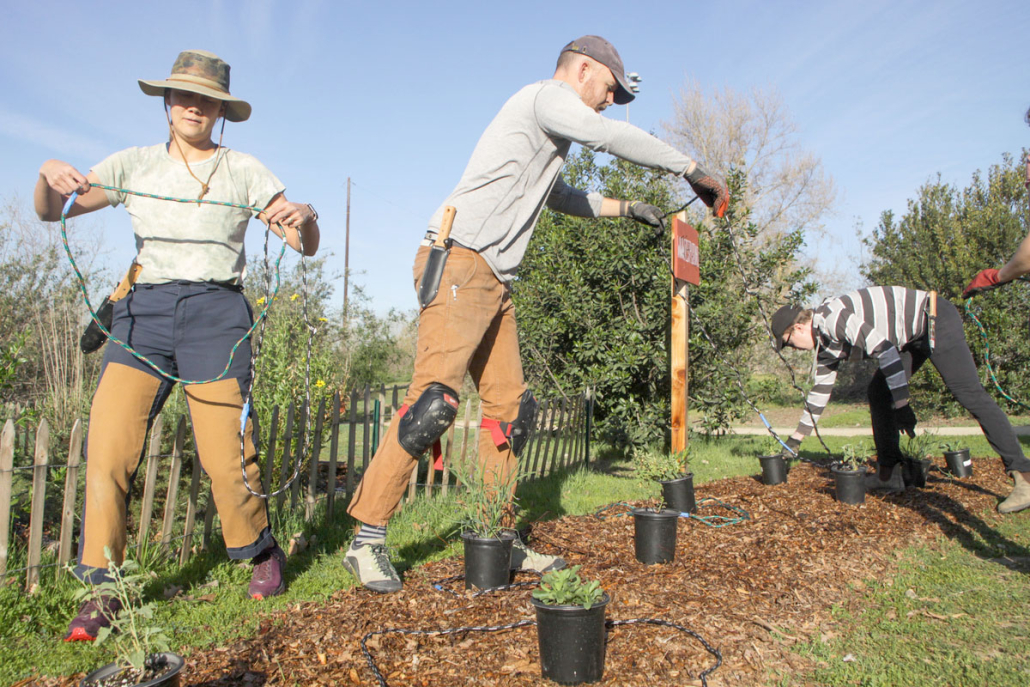Test Plot plants (native) seeds for restoration

On soil beds near the School of Architecture, a handful of people crouch around budding monkeyflowers, creeping barberry and red buckwheat with clipboards in hand, eyes squinted as they observe leaf irregularities and feel for soil moisture. The bunch — a mix of professors and graduate students — gather over a unifying cause and shared passion for native plants and ecological restoration.
Test Plot, an ecological restoration project involving faculty and students across the landscape architecture field at USC, began in 2019 as an experiment in community-based land stewardship. Its name is a riff on a borrowed agricultural term that refers to the test work farmers perform to maximize yield, reimagined to convey the project’s mission to test plant selection, community stewardship models and landscape maintenance strategies.
Jen Toy, a lecturer of landscape architecture, launched the project with the support and inspiration of landscape architecture firm Terramoto after recognizing the depleted ecological state suffered by some parks in the Los Angeles area. The team’s efforts began in Elysian Park, a beloved city green space, where they worked with citizens’ committees and local volunteers on a restoration project.
With an initial site off the ground, Toy brought Test Plot to USC, where she began to teach a class anchored in hands-on experiential learning through planting and site monitoring. Three restoration sites have been initiated since: one in the Baldwin Hills Scenic Overlook, one in Rio de Los Angeles State Park and one right on University Park Campus. All Test Plot offshoots aim to incorporate existing caretakers and residents of the communities in which they’re based, Toy said.
“Our mission is basically to empower folks to engage in community land stewardship to promote biodiversity and address climate crises,” Toy said.
Hannah Flynn, a self-proclaimed “plant nerd” and a graduate student studying landscape architecture, joined Test Plot this past summer after working as a research assistant for Toy. She has used the adjoining class to complement her studies by not only designing for plants, but learning from them.

“As landscape architects … even though we’re designing for the outdoors, I think we can get a little divorced or a little far away from what we’re designing for,” Flynn said. “[Toy] came into our theory class that all the first-years take and talked a lot about the value of landscape architects, understanding the maintenance of landscape and the relationship that you have to a space when you’re working with it on an ongoing basis.”
Flynn was heavily involved in the site at Rio de Los Angeles, a park born out of the engagement of 36 community organizations that coalesced to reclaim the land for shared recreation and restoration. Flynn said she found the intentionality of Test Plot visits and work, as well as the relationships she built with the park and the community members that help maintain it, the most fruitful parts of her experience with the project.
Asher Guzik, a graduate student studying landscape architecture, began helping out with Test Plot last August, his interest in the project stemming from his background in native plant horticulture. He worked his first job at a nonprofit specializing in native plants and chose to come to Southern California to further his studies in native ecology. Joining Test Plot has served as a way for him to combine studio work in the landscape architecture field with work physically on the field.
“It’s also really important for people going into landscape design to feel that they understand what it takes to actually put things in the ground, separating it from computers or models,” Guzik said.
The Test Plot independent study class, which Flynn is taking, is co-taught by Toy and Alexander Robinson, an associate professor of landscape architecture. The class’ instructors and students, along with several volunteers, established the USC campus plot — made up of the Rose Garden and Alley sites located in the shady walkways near the School of Architecture and the Roski School of Art and Design — over Spring Break.
The team is currently testing the appearance, growth and viability of the native plants planted at the plots in an overall effort to create a campus landscape suited for the local environmental conditions. With a background in large-scale landscapes, Robinson came into the project with limited experience and knowledge of native plants, but said he has grown “fairly obsessed” with them since.
“[Test Plot’s mission at USC is to] not just replace all of our decorative plants with native plants that are highly decorative, but to rethink the campus as an ecosystem and an environmental machine and then … rethink that kind of stewardship and engage the students with the landscape,” Robinson said.
The greatest challenges for the project so far, Toy said, have been receiving funding to upkeep the sites and provide for labor, as well as finding the right partner to be able to create Test Plots outside of the University. Toy said her dream is to establish a three-part model in which the project runs in partnership with community groups, Universities and land managers to test innovative solutions to pressing questions about Earth’s future.
“Every community in L.A. and every school across the state, really, can have a Test Plot,” Toy said.

